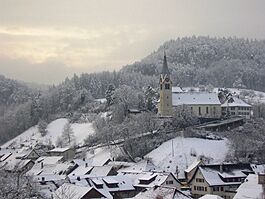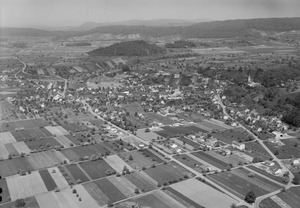Würenlingen facts for kids
Quick facts for kids
Würenlingen
|
||
|---|---|---|
 |
||
|
||
| Country | Switzerland | |
| Canton | Aargau | |
| District | Baden | |
| Area | ||
| • Total | 9.37 km2 (3.62 sq mi) | |
| Elevation | 370 m (1,210 ft) | |
| Population
(Dec 2020 )
|
||
| • Total | 4,838 | |
| • Density | 516.3/km2 (1,337.3/sq mi) | |
| Postal code |
5303
|
|
| Surrounded by | Böttstein, Döttingen, Endingen, Obersiggenthal, Tegerfelden, Untersiggenthal, Villigen | |
| Twin towns | Beringen (Switzerland) | |
Würenlingen is a town, also called a municipality, located in the Baden district. It is part of the canton of Aargau in Switzerland. This charming Swiss town is a great place to learn about geography, people, and how a community works.
Contents
Exploring Würenlingen's Geography
Würenlingen covers an area of about 9.4 square kilometers (3.6 square miles). Imagine a space about the size of 1,300 football fields! A big part of this land, almost half (49.4%), is covered by forests. These green areas are important for nature and offer places to explore.
About 29.2% of the land is used for farming. This means there are fields where crops are grown or animals graze. The town's buildings and roads take up 19.2% of the area. A small part, 2.2%, is made up of rivers or lakes.
Understanding Würenlingen's Coat of Arms
The blazon (official description) of Würenlingen's coat of arms is quite simple. It shows a green acorn with two leaves on a silver background. This symbol likely represents the natural beauty or history of the area.
Discovering Würenlingen's Population
Würenlingen is home to over 4,000 people. In 2008, about 21.6% of the people living here were from other countries. The town's population has been growing steadily, increasing by 9% over ten years.
Most people in Würenlingen speak German, which is the main language (88.5%). Other languages spoken include Albanian (2.8%) and Italian (2.0%). This shows the diverse mix of people who call Würenlingen home.
Age Groups in Würenlingen
The town has a good mix of different age groups.
- About 10.5% of the population are children aged 0 to 9 years old.
- Teenagers, aged 10 to 19, make up about 12.7% of the population.
- Young adults, aged 20 to 29, are about 13.6%.
- Adults aged 30 to 49 make up a large part, about 31.3%.
- Older adults, aged 50 to 69, are about 22.5%.
- Seniors, aged 70 and above, make up about 9.4% of the population.
Homes and Housing in Würenlingen
In 2000, there were many different types of homes in Würenlingen.
- About 108 homes had 1 or 2 people living in them.
- Most homes, 638 of them, had 3 or 4 people.
- Another 604 homes had 5 or more people.
On average, each household had about 2.57 people. In 2008, nearly half of all homes (42.5%) were single-family houses. There were very few empty apartments, showing that most homes were occupied.
Political Choices in Würenlingen
In the 2007 federal election, the most popular political party in Würenlingen was the SVP, which received 39% of the votes. Other popular parties included the CVP (26.3%), the SP (11.9%), and the FDP (10.9%). These parties represent different ideas about how the country should be run.
Education in Würenlingen
Education is important in Würenlingen. About 76.9% of adults (aged 25–64) have completed higher education. This means they have gone beyond basic schooling, either to a university or a specialized college.
In the 2008/2009 school year, 353 students attended primary school in the municipality. Another 123 students were attending secondary school within the town.
Notable Sights in Würenlingen
The village of Würenlingen is recognized as an important part of Switzerland's heritage. It is listed in the Inventory of Swiss Heritage Sites. This means the town has special historical or cultural value that is protected.
Würenlingen's Economy and Work Life
The economy of Würenlingen involves different types of jobs.
- The primary sector (like farming) employs 68 people in 15 businesses.
- The secondary sector (like manufacturing) employs 1,165 people in 57 businesses.
- The tertiary sector (like services and shops) employs 607 people in 93 businesses.
Many people who live in Würenlingen also work there. In 2000, about 1,399 people came into the town for work, while 1,342 residents worked outside Würenlingen. Most people (53%) used a private car to get to work, while 14.2% used public transportation.
Religious Life in Würenlingen
According to a 2000 survey, the main religions in Würenlingen are:
- Roman Catholic: 59.0% of the population (2,150 people).
- Swiss Reformed Church: 20.6% of the population (750 people).
A very small number of people (0.11%) belong to the Christian Catholic faith.
See also
 In Spanish: Würenlingen para niños
In Spanish: Würenlingen para niños







